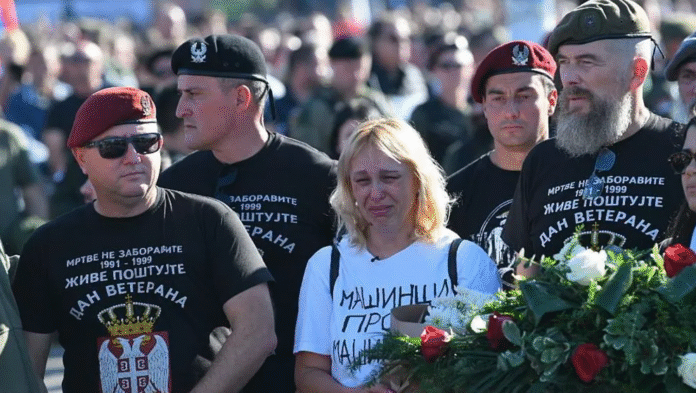Serbia Train Station Tragedy – A Year Later, the Pain Remains
The Serbia train station tragedy continues to cast a long, painful shadow over the people of Novi Sad. One year after the horrific collapse that claimed 16 innocent lives, grief and anger still dominate the nation’s collective memory. What was meant to be a symbol of progress has instead become a symbol of negligence, corruption, and government failure.
Last autumn, under the bright sunshine of an unseasonably warm day, dozens of people gathered beneath a newly renovated concrete canopy at the Novi Sad railway station. Without warning, the structure collapsed, leaving behind devastation and heartbreak. Among the victims were children as young as six and elders up to 77 years old.

A Silent Tribute to the Victims
On the anniversary of the Serbia train station tragedy, tens of thousands marched through Novi Sad’s streets to honor those who perished. At exactly 11:52 AM, the moment of the disaster, the city fell silent for 16 minutes, one for each life lost. Family members laid flowers, some sobbing uncontrollably, while others stood motionless in disbelief.
Despite the cleanup of debris, the station’s scars remain visible, broken glass and twisted metal serve as haunting reminders of what went wrong. For many, the untouched site represents not just physical damage, but moral decay at the heart of Serbia’s system.
A Modern Project Turned National Shame
The renovated Novi Sad station was once hailed as a milestone achievement under President Aleksandar Vučić’s Progressive Party. It was proudly inaugurated in 2022 alongside Hungary’s Prime Minister Viktor Orbán as part of a high-speed railway connecting Belgrade to Budapest.
What was envisioned as a showcase of modern engineering and progress has now turned into a cautionary tale. For many Serbians, the Serbia train station tragedy exposed deep cracks not only in the country’s infrastructure but also in its governance.
Protesters filled the streets carrying placards reading “Corruption Kills.” The message was clear, the tragedy wasn’t merely an accident; it was the deadly outcome of negligence and greed.
The Rise of Serbia’s Student Movement
In the wake of the Serbia train station tragedy, a new wave of activism emerged — led not by politicians but by students. University groups quickly took charge of organizing nationwide protests demanding accountability.
“People don’t trust traditional politicians anymore,” said Aleksa, a 23-year-old management student from Novi Sad University. “That’s why students are now the most trusted voices in Serbia.”
Unlike previous protests, these student-led movements have not faded away. They have inspired hope across generations, calling for new elections and a technocratic government run by independent experts, a bold attempt to cleanse Serbian institutions of corruption.
Accountability and Corruption Charges
Public outrage forced authorities to take action. In September, 13 people were formally charged, including former Minister of Construction and Transport Goran Vesić, accused of negligence and corruption linked to the collapse.
The European Parliament also weighed in, urging Serbia to ensure a full and transparent investigation and to examine the role corruption played in weakening safety standards.
(External Link: European Parliament Resolution — DoFollow)
However, government officials continue to deny any wrongdoing, calling the accusations politically motivated. This denial has only fueled further distrust among the public.
A Growing Political Divide
While President Vučić initially condemned the protests, branding them as a Western-backed “color revolution,” his tone changed dramatically on the eve of the anniversary. In a surprising turn, he apologized for his harsh words toward protesters, claiming regret for “things he should not have said.”
The students, however, were unmoved. Their response was blunt: “You have blood on your hands.”
The movement’s strength lies in its authenticity, these young Serbians are not driven by political ambition but by moral conviction. Their persistence has cut across party lines, uniting ordinary citizens tired of corruption and empty promises.
From Mourning to a Movement for Change
The Serbia train station tragedy has evolved from a national mourning event into a powerful symbol of resistance. Political scientist Srdjan Cvijić from the Belgrade Centre for Security Policy says the movement’s success lies in its credibility:
“Students have broken through the apathy that traditional opposition failed to overcome,” he explains. “They’ve reached the very voters who once supported the ruling party.”
This transformation has made the government nervous, as the once-untouchable ruling party faces its most serious challenge in years.
A Nation Still Searching for Justice
One year later, the victims’ families continue to wait for justice. They demand more than condolences; they want reform, safety, and accountability.
Many Serbians now see the Serbia train station tragedy as a turning point, a painful reminder that unchecked corruption can have deadly consequences.
Whether Serbia’s leaders will finally address the systemic failures that led to the collapse remains uncertain. But one thing is clear: the people will not stay silent again.

Hope Amid the Heartbreak
Despite their grief, many believe the tragedy has awakened Serbia’s conscience. A year later, the movement for justice still grows, fueled by ordinary citizens demanding honesty and safety in their country’s future.
In the words of one protester, “We are not just fighting for the 16 lives lost, we’re fighting for the next 16 who shouldn’t have to die.”

